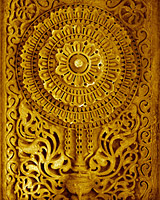 The census town Adalaj is located in the Gandhinagar district in the state of Gujarat, which forms a part of the Indian subcontinent. The town of Adalaj is at a distance of 19 kilometers from Ahmedabad and 5 kilometers from Gandhinagar. The history of this town can be dated to prehistoric times. It can be reached from either of the two cities by road. The major tourist attraction in this village is the world famous architectural wonder known as Adalaj Vav.
The census town Adalaj is located in the Gandhinagar district in the state of Gujarat, which forms a part of the Indian subcontinent. The town of Adalaj is at a distance of 19 kilometers from Ahmedabad and 5 kilometers from Gandhinagar. The history of this town can be dated to prehistoric times. It can be reached from either of the two cities by road. The major tourist attraction in this village is the world famous architectural wonder known as Adalaj Vav.
Adalaj Vav
This is a five storied architectural marvel built by Queen Rudabai in the sleepy village of Adalaj. This is also regarded as one of the finest monuments of Gujarat and is an excellent blend of Hindu and Islamic style of architecture. It was mainly constructed to serve religious and utilitarian purposes of the local people around. The history of this monument is however marred by tragedy. The origin of this monument can however be traced back to ancient times when the area around Adalaj was known as Dandai Desh and was under the reign of Rana Veer Singh of the powerful Vaghela dynasty. It was during this time that a  Muslim ruler of the neighboring state by the name of Mohammed Begda attacked Dandai Desh and killed the ruling monarch. The beauty of the slain king`s widow enamored the Muslim monarch and immediately sent her a proposal of marriage. The determined empress agreed to tie the knot on the condition that he would construct her a five-storied step wall. Mohammed Begda was so enticed by the queen`s charm that he at once agreed to her condition and thus the far-famed wonder was built and the beauty of it stands unrivalled till today. The intricate carvings of floral patterns, the depiction of animal and human forms make this monument scale all the heights of architectural grandeur.
Muslim ruler of the neighboring state by the name of Mohammed Begda attacked Dandai Desh and killed the ruling monarch. The beauty of the slain king`s widow enamored the Muslim monarch and immediately sent her a proposal of marriage. The determined empress agreed to tie the knot on the condition that he would construct her a five-storied step wall. Mohammed Begda was so enticed by the queen`s charm that he at once agreed to her condition and thus the far-famed wonder was built and the beauty of it stands unrivalled till today. The intricate carvings of floral patterns, the depiction of animal and human forms make this monument scale all the heights of architectural grandeur.
Another interesting feature of this architectural wonder is an inscription written in the Sanskrit language, which tells the entire history to its visitors with exact dates.



















